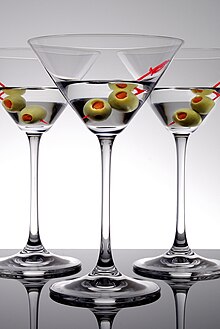Martini (cocktail)
| IBA official cocktail | |
|---|---|
 The martini is one of the most widely known cocktails | |
| Type | Cocktail |
| Base spirit | |
| Served | Straight up: chilled, without ice |
| Standard garnish | Olive or lemon peel |
| Standard drinkware | |
| IBA specified ingredients† | |
| Preparation | Pour all ingredients into mixing glass with ice cubes. Stir well. Strain in chilled martini cocktail glass. Squeeze oil from lemon peel onto the drink, or garnish with olive. |
| † Martini recipe at International Bartenders Association | |
The martini is a cocktail made with gin and vermouth, and garnished with an olive or a lemon twist. Over the years, the martini has become one of the best-known mixed alcoholic beverages. H. L. Mencken called the martini "the only American invention as perfect as the sonnet"[1] and E. B. White called it "the elixir of quietude".[2]
Preparation

Pouring all ingredients into a mixing glass with ice cubes, the ingredients are mixed then strained and served "straight up" (without ice) in a chilled cocktail glass and garnished with either a green olive or a twist of lemon (a strip of the peel, usually squeezed or twisted to express volatile oils onto the surface of the drink).
Although there are many variations, in modern practice the standard martini is a mix of gin coupled with dry vermouth usually in a five-to-one ratio. Shaker mixing is common due to influences of popular culture, notably the fictional spy James Bond, who always asked for his vodka martini to be "shaken, not stirred". However, stirring has a long history. Harry Craddock's Savoy Cocktail Book (1930) prescribes stirring for all its martini recipes.
Noel Coward suggested that a perfect martini should be made by "filling a glass with gin then waving it in the general direction of Italy" (which along with France are two major producers of vermouth), meaning the less vermouth added to the gin the better the resulting drink.[citation needed]
The dryness of a martini refers to the amount of vermouth used in the drink, with a very dry martini having little or no Vermouth.[3]. Conversely, a wet martini has a significant amount of vermouth added.[4]
A dirty martini contains a splash of olive brine or olive juice.[5]
Martini origins and mixology
The exact origin of the martini is unclear. Numerous cocktails with names and ingredients similar to the modern-day martini were first seen in bartending guides of the late 19th century.[6] One popular theory suggests it evolved from a cocktail called the Martinez served at the Occidental Hotel in San Francisco sometime in the early 1860s, which people frequented before taking an evening ferry to the nearby town of Martinez. Alternatively, the people of Martinez say the drink was first created by a bartender in their town.[7] Another theory links the first dry martini to the name of a bartender who concocted the drink at the Knickerbocker Hotel in New York City in 1911 or 1912.[8]
But it was Prohibition and the relative ease of illegal gin manufacture that led to the martini's rise as the predominant cocktail of the mid 20th century in the United States. With the repeal of Prohibition, and the ready availability of quality gin, the drink became progressively dryer. In the 1970s and 80s, the martini came to be seen as old-fashioned and was replaced by more intricate cocktails and wine spritzers, but the mid-1990s saw a resurgence in the drink and an explosion of new versions.
Some newer drinks include the word "martini" or the suffix "-tini" in the name (e.g., appletini, peach martini, chocolate martini, espresso martini); however, these are simply named after the cocktail glass they share with the martini and do not share any ingredients in common, and therefore should not be considered variants of the martini.
See also
- Three martini lunch
- Gibson (cocktail)
- Vesper (cocktail)
- Bronx (cocktail)
- List of cocktails
- List of martini variations
- Martini Shot, a film industry term for the last shot of the day, because "the next shot is out of a glass"
References
- ^ Edmunds, Lowell (1981). Martini, Straight Up: The Classic American Cocktail. Johns Hopkins University Press. ISBN 0-8018-5971-9.
- ^ Conrad, Barnaby, III (1995). The Martini: An Illustrated History of an American Classic. Chronicle Books. pp. 10–11. ISBN 0-8118-0717-7.
{{cite book}}: CS1 maint: multiple names: authors list (link) - ^ "High and Dry". Salon.com. 9 April 1997. Retrieved 22 March 2011.
- ^ "COCKTAILS: The Wet Martini". 16 June 2009.
- ^ Bloom. The Complete Bartender's Guide. Carlton Books. p. 95. ISBN 184222736X.
{{cite book}}: Unknown parameter|firth=ignored (help) - ^ Edmunds, Lowell (1998). Martini, Straight Up: The Classic American Cocktail. Johns Hopkins University Press. p. 81. ISBN 9780801873119.
- ^ Taylor, David (2002). Martini. Silverback Books. p. 8. ISBN 9781930603035.
- ^ The Court of Historical Review in San Francisco ruled that the martini was invented in San Francisco. A court in Martinez, California, recently overturned this decision Gasnier, Vincent (2007). Drinks. DK Adult. p. 376.
External links
- Gadberry, Brad (12 January 2008). "The Martini FAQ". Retrieved 10 August 2008.
- History of the Martini: A talk with Max Rudin 29 December 1997 (real audio format)

